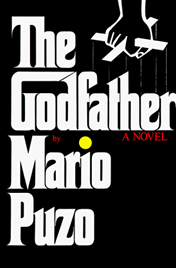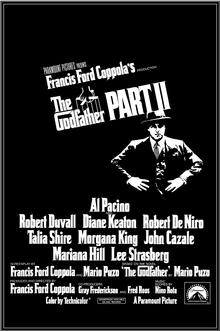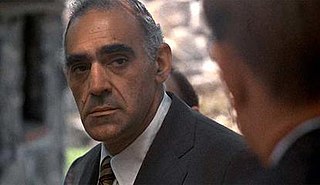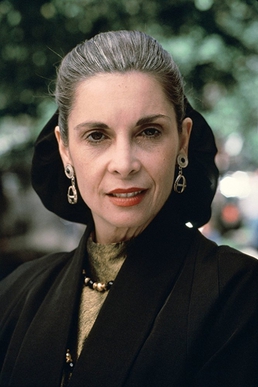
The Godfather is a crime novel by American author Mario Puzo. Originally published in 1969 by G. P. Putnam's Sons, the novel details the story of a fictional Mafia family in New York City, headed by Vito Corleone, the Godfather. The novel covers the years 1945 to 1955 and includes the back story of Vito Corleone from early childhood to adulthood.

The Godfather Part II is a 1974 American epic crime film. The film is produced and directed by Francis Ford Coppola, loosely based on the 1969 novel The Godfather by Mario Puzo, who co-wrote the screenplay with Coppola. It is both a sequel and a prequel to the 1972 film The Godfather, presenting parallel dramas: one picks up the 1958 story of Michael Corleone, the new Don of the Corleone family, protecting the family business in the aftermath of an attempt on his life; the prequel covers the journey of his father, Vito Corleone, from his Sicilian childhood to the founding of his family enterprise in New York City. The ensemble cast also features Robert Duvall, Diane Keaton, Talia Shire, Morgana King, John Cazale, Mariana Hill, and Lee Strasberg.

Meyer Lansky, known as the "Mob's Accountant", was an American organized crime figure who, along with his associate Charles "Lucky" Luciano, was instrumental in the development of the National Crime Syndicate in the United States.

Michael Corleone is a fictional character and the protagonist of Mario Puzo's 1969 novel The Godfather. In the three Godfather films, directed by Francis Ford Coppola, Michael was portrayed by Al Pacino, for which he was twice-nominated for Academy Awards. Michael is the youngest son of Vito Corleone, a Sicilian immigrant who builds a Mafia empire. Upon his father's death, Michael succeeds him as the don of the Corleone crime family.

Vito Corleone is a fictional character in Mario Puzo's 1969 novel The Godfather and in the first two of Francis Ford Coppola's film trilogy. Vito is originally portrayed by Marlon Brando in the 1972 film The Godfather, and later by Oreste Baldini as a boy and by Robert De Niro as a young man in The Godfather Part II (1974). He is an orphaned Sicilian immigrant who builds a Mafia empire.

Frederico "Fredo" Corleone is a fictional character in Mario Puzo's 1969 novel The Godfather. Fredo is portrayed by American actor John Cazale in the Francis Ford Coppola 1972 film adaptation and in the 1974 sequel, The Godfather Part II.

Santino "Sonny" Corleone is a fictional character in Mario Puzo's 1969 novel The Godfather and its 1972 film adaptation.

Vincent SantinoCorleone is a fictional character in the 1990 feature film The Godfather Part III. He is portrayed by Andy García, who was nominated for an Academy Award for his performance.
The Corleone family are fictional characters in both the novels and the films created by Mario Puzo, first appearing in his 1969 novel, The Godfather. They are an organized crime family originating from the Sicilian town of Corleone, and based in New York City.

Thomas Hagen is a fictional character in Mario Puzo's 1969 novel The Godfather and Francis Ford Coppola's films The Godfather (1972) and The Godfather Part II (1974). He is portrayed by Robert Duvall in the films. He also appears in the Mark Winegardner sequel novels The Godfather Returns and The Godfather's Revenge, as well as Ed Falco's novel The Family Corleone. Duvall was nominated for an Academy Award for Best Supporting Actor and a BAFTA for his performance in the first film.

Peter Clemenza is a fictional character who first appeared in Mario Puzo's 1969 novel The Godfather. He is played by Academy Award-nominee Richard Castellano in Francis Ford Coppola's 1972 film adaptation of the novel, and by Bruno Kirby in The Godfather Part II (1974).

Salvatore "Sal" Tessio is a fictional character in Mario Puzo's 1969 novel The Godfather, as well as two of the films based on it: The Godfather (1972) and The Godfather Part II (1974). His given name was created for the films; in the novel he is referred to only as "Tessio". In the film The Godfather, Tessio was portrayed by Abe Vigoda. In The Godfather Part II, John Aprea portrayed the younger Tessio, while Vigoda reprised the role in a flashback, set in late 1941, at the end of the film.

Frank Pentangeli is a fictional character from the 1974 film The Godfather Part II, portrayed by Michael V. Gazzo. Gazzo was nominated for a Best Supporting Actor Oscar for his performance, which he lost to Robert De Niro, his co-star from the same film. He is nicknamed "Frankie Five Angels" from his last name, which is formed from the Greek-derived prefix penta- and the Italian word angeli ("angels").

Albert "Al" Neri is a fictional character appearing in Mario Puzo's 1969 novel The Godfather and Francis Ford Coppola's trilogy of films based on it. In all three motion pictures, he is portrayed by actor Richard Bright. He functions as Michael Corleone's personal enforcer, bodyguard and assassin.

Emilio "The Wolf" Barzini is a fictional character and the main antagonist in Mario Puzo's 1969 novel The Godfather and in its 1972 film adaptation, in which he is portrayed by Richard Conte. The Barzini crime family was inspired by the Genovese crime family.

Morris "Moe" Greene is a fictional character appearing in Mario Puzo's 1969 novel The Godfather and the 1972 film of the same title. Both Greene's character and personality are based on Bugsy Siegel: his affiliation with the mob in Los Angeles, his involvement in the development of Las Vegas, and his flamboyant tendencies. Greene is portrayed in the movie by Alex Rocco.

Carlo Rizzi is a fictional character in Mario Puzo's 1969 novel The Godfather. In the 1972 film adaptation, he was portrayed by Gianni Russo.

The Godfather II is a 2009 action-adventure game developed by EA Redwood Shores and published by Electronic Arts. It was released for Microsoft Windows, PlayStation 3, and Xbox 360 in April. Based on the 1974 film The Godfather Part II, it is the sequel to the 2006 game The Godfather, which was based on the 1972 film of the same name. Like the first game, The Godfather II follows a non-canon character, Dominic, who is initially the protégé and underboss of the original game's protagonist, Aldo Trapani. After Aldo is killed, Dominic is placed in charge of the Corleone family's operations in New York City and tasked with expanding the Corleone empire by taking out their rivals. Unlike the first game, which was primarily set in New York, the story also spans Miami and Havana.

Constanzia "Connie" Corleone is a fictional character in The Godfather, a 1969 novel by Mario Puzo, and the 1972 film The Godfather. In the film, Connie is portrayed by Talia Shire, the sister of the director Francis Ford Coppola. Shire was nominated for the Academy Award for Best Supporting Actress for her portrayal of Connie Corleone in The Godfather Part II.


















